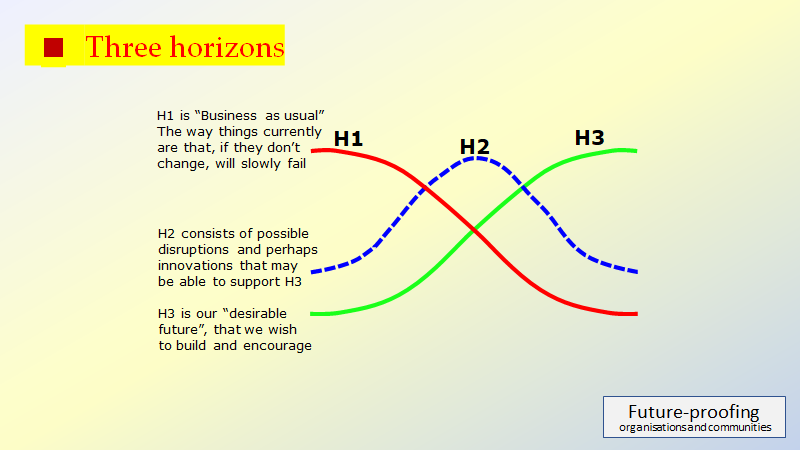Scenario Planning (Cont.) In Summary
"...decision-makers who can expand their imaginations to see a wide range of possible futures will be much better positioned to take advantage of the unexpected opportunities that will inevitably come along..."
Paul Schoemaker et al, as quoted by David Stauffer, 2002
"...There is no singular future. It has to be seen in multiples and multiple possibilities..."
Chris Luebkeman has quoted by Sheridan Win, 2011
. There are 2 distinct approaches to scenario planning
- considering future scenarios helps managers to be more adaptive in their thoughts and actions about handling the future, ie the process makes the manager more thoughtful about the future
- examining scenarios in order to develop responses to them
. Scenario planning is
"...Learning by doing ... a planning activity that involves more play than analysis, more art than science, and more exploration than discovery ... provides a route to a world that may become real. It relies on the power of storytelling and involves mechanisms to integrate complex variables into a coherent, plausible and comprehensive whole. Foretelling the future using stories is seen to generate greater realism than simply extrapolating trends based on hard data. Hard data can be part of the scenario, but other contributions come from educated guesses, beliefs, experience, perceptions and intuition..."
Harry Osman, 2004d
. How to implement to achieve the benefits:
- determine the scope and timeframe of the scenario being studied
- identify current assumptions and mental models of individuals who can influence these decisions
- create a manageable number of divergent, yet plausible, scenarios. Determine the underlying assumptions of how each of these imagined futures might evolve
- test the impact of key variables in each scenario
- develop action plans based upon either the most robust solutions of each scenario or the most desirable outcome towards which an organisation can direct its efforts
- monitor events as they unfold to test the corporate direction; be prepared to modify as required
. In other words
- critical success factors or drivers need to be determined and prioritised
- the uncertainties need to be identified and prioritised; with the appropriate risk management system put in-place
- the necessary changes to the organisation for each scenario need to be made explicit
. Some educational experiences include
- stretching your mind beyond the "group think" that can produce sameness
- remembering that apparently remote potential developments may have repercussions elsewhere
- anticipating how you and your colleagues might respond under both adverse and favorable conditions
. Some general rules in effective scenario planning are
- develop a limited number of alternatives or scenarios (around 5 ), eg
i) a "business as usual" scenario (no change)
ii) a pessimistic scenario (negative)
iii) an optimistic scenario (positive)
iv) a pragmatic scenario (realistic)
v) "left field" scenario (extreme)
NB Another way of saying this is to work with "3 Ps and a W", ie the possible, probable and preferential futures, plus a wild card
Another simplified form of scenario planning is to look at 3 scenarios or horizons (H1, H2 & H3)
The vertical axis is how well they fit into the current situation; horizontal axis is time.

(source: Bob Dick, 2023)
Look at your current pattern of behaviours and determine which ones you expect to continue as part of the future; what will be their impact, ie improve things or make things worse?
Articulate what a desirable future would look like, ie key features.
In H2, most initiatives will be entrepreneurial around technology and a high percentage will fail; identify current disturbances and innovations, like AI, etc that are and will have impacts; which ones should you either encourage and support or discourage?
- each alternative should offer a distinct picture of the industry's structure
- each alternative should offer a distinct picture of the industry's structure, conduct and performance
- develop a set of alternatives that collectively account for a probable range of future outcomes and not necessarily the entire possible range, ie they are both plausible and surprising
- achieve a balanced focus on opportunities and catastrophes (NB scenario planning is not a substitute for crisis planning)
- do not forget to look at behaviourial changes required to handle each scenario and their impact in each scenario
- need to look at both macro and micro impacts, ie general and specific impacts in each scenario
. Remember
- allocate your resources prudently
- preserve your options and flexibility to handle unknown outcomes
- ensure that yesterday's logic is not used to solve today's problem, ie scenario planning does not look back - it looks forward
- allow the opportunity to rehearse, ie developing a memory for the possibilities in the future without the intense involvement of the emotions. Remember,
"...chance favours the prepared mind..."
Louis Pasteur as quoted by David Stauffer, 2002
- context is pivotal; with the relationship between things being important
- explore new relationships rather than new ideas. This comes from combining general and specific knowledge, ie general knowledge involves understanding the way the wider world functions (big picture, macro trends, etc); specific knowledge is the details of the problem you are investigating (micro trends, etc)
(sources: Art Kleiner, 1996; David Stauffer, 2002; Leon Getter, 2002a; Bill Synnot, 1999a; Fiona Carruthers, 2005; Harry Osman, 2004d; Geoffrey Colvin, 2005a; Justin Fox, 2005; Peter Senge et al, 2005; Nassim Taleb, 2007; Andrew Cornell, 2008a; Glenn Mumford, 2008; Richard Rasker, 2009; Marion Hume, 2010a; Sheridan Winn, 2011; Rachel Lebihan, 2012a),
